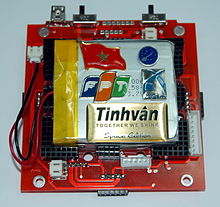 Flight Model of F-1 satellite | |
| Mission type | Technology demonstration |
|---|---|
| Operator | FPT University/Uppsala University |
| COSPAR ID | 2012-038E (1998-067CR)[1] |
| SATCAT no. | 38855 |
| Mission duration | Failed to contact ground 100 days (planned) |
| Spacecraft properties | |
| Spacecraft type | CubeSat |
| Manufacturer | FPT University |
| Launch mass | 1 kg (2.2 lb) |
| Dimensions | 10 cm x 10 cm x 10 cm (1U) |
| Start of mission | |
| Launch date | 21 July 2012, 02:06:18 UTC[2] |
| Rocket | H-IIB F3 |
| Launch site | Tanegashima, Yoshinobu LC-Y2 |
| Contractor | Mitsubishi Heavy Industries |
| Deployed from | ISS Kibō Delivered by Kounotori 3 |
| Deployment date | 4 October 2012, 15:44:15.297 UTC |
| Entered service | Failed to contact ground |
| End of mission | |
| Decay date | 9 May 2013[3] |
| Orbital parameters | |
| Reference system | Geocentric orbit |
| Regime | Low Earth orbit |
| Inclination | 51.65° |
 F-1 mission patch | |
F-1 is a CubeSat built by FSpace laboratory at FPT University, in Hanoi, Vietnam, in partnership with Angstrom Space Technology Center (ASTC), Uppsala University, Sweden and Nanoracks LLC, United States. Its mission is to train young engineers and students about aerospace engineering and evaluate an advanced three-axis magnetometer, Spin-Dependent Tunneling Magnetometer (SDTM) designed in Sweden by ASTC.[4]
F-1 was launched on 21 July 2012 and delivered to the International Space Station (ISS) aboard Kounotori 3 (HTV-3) along with the RAIKO, WE WISH, Niwaka and TechEdSat-1 cubesats. Then, on 4 October 2012, it was deployed into orbit from the ISS using the JEM-Small Satellite Orbital Deployer (J-SSOD) which was attached to the Kibō module's robotic arm.[5][6]
As of 2 November 2012, F-1 failed to confirm communication after the orbital deployment.[7]


